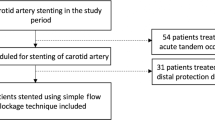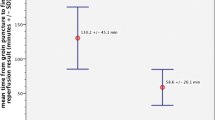Abstract
Purpose
Tandem occlusive lesions are responsible for up to 20% of acute ischemic stroke cases and are associated with poor prognosis if complete recanalization cannot be achieved. Endovascular recanalization might be challenging due to difficulties in the safe passage of the occluded plaque at the origin of the internal carotid artery (ICA). The balloon-assisted tracking technique (BAT), where a partially deflated balloon is exposed out of the catheter tip to facilitate its passage through stenosed or spastic arterial segments was introduced by interventional cardiologists and the applicability of the technique has been recently proposed in the field of neurointervention as well. Here we describe our experience using the BAT technique in the endovascular recanalization of tandem occlusive lesions.
Methods
Procedures were performed from June 2013 to December 2020 in a single center. Baseline clinical and imaging data, procedural and follow-up details and clinical outcomes were retrospectively collected.
Results
In this study 107 patients, median age 66 years, median admission NIHSS 14 and median ASPECTS 8 were included. Successful recanalization of the ICA using the BAT technique was achieved in 100 (93%) and successful intracranial revascularization in 88 (82%) patients. There were no complications attributable to the BAT technique. Intraprocedural complications occurred in 9 (8%) patients. Emergent stenting was performed in 40 (37%) at the end of the procedure. Postprocedural adverse events (intracerebral hemorrhage [ICH], malignant infarction) occurred in 6 (5%) patients. Good clinical outcome at 3 months (modified Rankin scale [mRS] 0–2) was 54 (50%) and mortality 26 (24%). Delayed stent placement during follow-up occurred in 21 cases.
Conclusion
Application of BAT technique in tandem occlusions appears feasible, safe, and efficient. Further evaluation of this technique is awaited.


Similar content being viewed by others
References
Grau AJ, Weimar C, Buggle F, Heinrich A, Goertler M, Neumaier S, Glahn J, Brandt T, Hacke W, Diener HC. Risk factors, outcome, and treatment in subtypes of ischemic stroke: the German stroke data bank. Stroke. 2001;32:2559–66.
Pechlaner R, Knoflach M, Matosevic B, Ruecker M, Schmidauer C, Kiechl S, Willeit J. Recanalization of extracranial internal carotid artery occlusion after i.v. thrombolysis for acute ischemic stroke. PLoS One. 2013;8:e55318.
Rubiera M, Ribo M, Delgado-Mederos R, Santamarina E, Delgado P, Montaner J, Alvarez-Sabín J, Molina CA. Tandem internal carotid artery/middle cerebral artery occlusion: an independent predictor of poor outcome after systemic thrombolysis. Stroke. 2006;37:2301–5.
Goyal M, Menon BK, van Zwam WH, Dippel DW, Mitchell PJ, Demchuk AM, Dávalos A, Majoie CB, van der Lugt A, de Miquel MA, Donnan GA, Roos YB, Bonafe A, Jahan R, Diener HC, van den Berg LA, Levy EI, Berkhemer OA, Pereira VM, Rempel J, Millán M, Davis SM, Roy D, Thornton J, Román LS, Ribó M, Beumer D, Stouch B, Brown S, Campbell BC, van Oostenbrugge RJ, Saver JL, Hill MD, Jovin TG; HERMES collaborators. Endovascular thrombectomy after large-vessel ischaemic stroke: a meta-analysis of individual patient data from five randomised trials. Lancet. 2016;387:1723–31.
Patel T, Shah S, Pancholy S, Rao S, Bertrand OF, Kwan T. Balloon-assisted tracking: a must-know technique to overcome difficult anatomy during transradial approach. Catheter Cardiovasc Interv. 2014;83:211–20.
Vajda Z, Nagy C, Balogh G, Radnai P, Repa I, Nagy F. Endovascular recanalization of proximal ICA occlusion in acute ischemic stroke: the stylet-balloon technique. Interv Neuroradiol. 2017;23(1S):68.
Burkhardt JK, Shapiro M, Tanweer O, Litao M, Chancellor B, Raz E, Riina HA, Nelson PK. Balloon-assisted tracking technique to overcome intracranial stenosis during thrombectomy for stroke. J Neurointerv Surg. 2019;11:e1.
Walker M, Kim LJ, Levitt MR, Ghodke B. Spasm, stenosis and shelves: balloon-assisted tracking techniques in endovascular interventions. J Cerebrovasc Endovasc Neurosurg. 2020;22:26–30.
Moshayedi P, Liebeskind DS, Jadhav A, Jahan R, Lansberg M, Sharma L, Nogueira RG, Saver JL. Decision-Making Visual Aids for Late, Imaging-Guided Endovascular Thrombectomy for Acute Ischemic Stroke. J Stroke. 2020;22:377–86.
Dotter CT, Judkins MP. Percutaneous transluminal treatment of arteriosclerotic obstruction. Radiology. 1965;84:631–43.
Poppe AY, Jacquin G, Roy D, Stapf C, Derex L. Tandem Carotid Lesions in Acute Ischemic Stroke: Mechanisms, Therapeutic Challenges, and Future Directions. AJNR Am J Neuroradiol. 2020;41:1142–8.
Hackam DG. Prognosis of Asymptomatic Carotid Artery Occlusion: Systematic Review and Meta-Analysis. Stroke. 2016;47:1253–7.
Kappelhof M, Marquering HA, Berkhemer OA, Borst J, van der Lugt A, van Zwam WH, Vos JA, Lycklama À Nijeholt G, Majoie CBLM, Emmer BJ; MR CLEAN Investigators. Accuracy of CT Angiography for Differentiating Pseudo-Occlusion from True Occlusion or High-Grade Stenosis of the Extracranial ICA in Acute Ischemic Stroke: A Retrospective MR CLEAN Substudy. AJNR Am J Neuroradiol. 2018;39:892–8.
Jadhav AP, Zaidat OO, Liebeskind DS, Yavagal DR, Haussen DC, Hellinger FR Jr, Jahan R, Jumaa MA, Szeder V, Nogueira RG, Jovin TG. Emergent Management of Tandem Lesions in Acute Ischemic Stroke. Stroke. 2019;50:428–33.
Wilson MP, Murad MH, Krings T, Pereira VM, O’Kelly C, Rempel J, Hilditch CA, Brinjikji W. Management of tandem occlusions in acute ischemic stroke - intracranial versus extracranial first and extracranial stenting versus angioplasty alone: a systematic review and meta-analysis. J Neurointerv Surg. 2018;10:721–8.
Dufort G, Chen BY, Jacquin G, Keezer M, Labrie M, Rioux B, Stapf C, Ziegler D, Poppe AY. Acute carotid stenting in patients undergoing thrombectomy: a systematic review and meta-analysis. J Neurointerv Surg. 2021;13:141–5.
Zhu F, Hossu G, Soudant M, Richard S, Achit H, Beguinet M, Costalat V, Arquizan C, Consoli A, Lapergue B, Rouchaud A, Macian-Montoro F, Biondi A, Moulin T, Marnat G, Sibon I, Paya C, Vannier S, Cognard C, Viguier A, Mazighi M, Obadia M, Hassen WB, Turc G, Clarençon F, Samson Y, Dumas-Duport B, Preterre C, Barbier C, Boulanger M, Janot K, Annan M, Bricout N, Henon H, Soize S, Moulin S, Labeyrie MA, Reiner P, Pop R, Wolff V, Ognard J, Timsit S, Reyre A, Perot C, Papagiannaki C, Triquenot-Bagan A, Bracard S, Anxionnat R, Derelle AL, Tonnelet R, Liao L, Schmitt E, Planel S, Guillemin F, Gory B. Effect of emergent carotid stenting during endovascular therapy for acute anterior circulation stroke patients with tandem occlusion: A multicenter, randomized, clinical trial (TITAN) protocol. Int J Stroke. 2021;16:342–8.
ClinicalTrials.gov, National Library of Medicine.Identifier NCT04261478, Endovascular Acute Stroke Intervention—Tandem OCclusion Trial (EASI-TOC). 2021. https://clinicaltrials.gov/ct2/show/NCT04261478. Accessed 18 Mar 2021.
Feil K, Herzberg M, Dorn F, Tiedt S, Küpper C, Thunstedt DC, Papanagiotou P, Meyer L, Kastrup A, Dimitriadis K, Liebig T, Dieterich M, Kellert L; GSR investigators†. Tandem Lesions in Anterior Circulation Stroke: Analysis of the German Stroke Registry-Endovascular Treatment. Stroke. 2021;52:1265–75.
Lapergue B, Blanc R, Gory B, Labreuche J, Duhamel A, Marnat G, Saleme S, Costalat V, Bracard S, Desal H, Mazighi M, Consoli A, Piotin M; ASTER Trial Investigators. Effect of Endovascular Contact Aspiration vs Stent Retriever on Revascularization in Patients With Acute Ischemic Stroke and Large Vessel Occlusion: The ASTER Randomized Clinical Trial. JAMA. 2017;318:443–52.
Funding
This research received no specific grant from any funding agency in the public, commercial or not-for-profit sectors. The research was conducted as part of a doctoral program at the Doctoral School of the University of Pécs, Faculty of Health Sciences, Hungary.
Author information
Authors and Affiliations
Contributions
All authors made a significant contribution to the study and to manuscript preparation. CN, JH, FN and ZV contributed to study conception and design, CN, JH, GBG, IG, SN, GL, MF and GBK contributed to data acquisition and MM and IR contributed to data interpretation and analysis. CN and ZV drafted the manuscript, GL, MF, GBK, MM, IR and FN critically revised the paper, and IR contributed significantly to the intellectual content. CN, MM, IR, FN and ZV approved the final version of the manuscript.
Corresponding author
Ethics declarations
Conflict of interest
C. Nagy, J. Héger, G. Balogh, I. Gubucz, S. Nardai, G. Lenzsér, G. Bajzik, M. Fehér, M. Moizs, I. Repa, F. Nagy and Z. Vajda declare that they have no competing interests.
Ethical standards
This retrospective analysis was conducted with approval of the Moritz Kaposi Teaching Hospital Institutional Review Board (IKEB/02163-000/2020). Consent to participate: informed consent for the study was waived due to the retrospective nature of the study; however, patients or a family member gave informed consent for the endovascular procedures. Consent for publication: publication has been approved by all co-authors.
Additional information
Availability of Data and Material
Questions regarding details not seen in the manuscript should be addressed to Zsolt Vajda M.D., Ph.D., the corresponding author, who maintains the clinical research files and provides access to the data upon reasonable request.
Code availability
Not applicable.
Rights and permissions
About this article
Cite this article
Nagy, C., Héger, J., Balogh, G. et al. Endovascular Recanalization of Tandem Internal Carotid Occlusions Using the Balloon-assisted Tracking Technique.. Clin Neuroradiol 32, 375–384 (2022). https://doi.org/10.1007/s00062-021-01078-2
Received:
Accepted:
Published:
Issue Date:
DOI: https://doi.org/10.1007/s00062-021-01078-2




